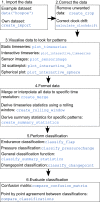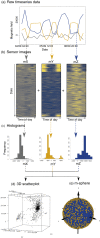pamlr: A toolbox for analysing animal behaviour using pressure, acceleration, temperature, magnetic or light data in R
- PMID: 35362103
- PMCID: PMC9542251
- DOI: 10.1111/1365-2656.13695
pamlr: A toolbox for analysing animal behaviour using pressure, acceleration, temperature, magnetic or light data in R
Abstract
Light-level geolocators have revolutionised the study of animal behaviour. However, lacking spatial precision, their usage has been primary targeted towards the analysis of large-scale movements. Recent technological developments have allowed the integration of magnetometers and accelerometers into geolocator tags in addition to barometers and thermometers, offering new behavioural insights. Here, we introduce an R toolbox for identifying behavioural patterns from multisensor geolocator tags, with functions specifically designed for data visualisation, calibration, classification and error estimation. More specifically, the package allows for the flexible analysis of any combination of sensor data using k-means clustering, expectation maximisation binary clustering, hidden Markov models and changepoint analyses. Furthermore, the package integrates tailored algorithms for identifying periods of prolonged high activity (most commonly used for identifying migratory flapping flight), and pressure changes (most commonly used for identifying dive or flight events). Finally, we highlight some of the limitations, implications and opportunities of using these methods.
Les géolocalisateurs lumineux ont révolutionné l'étude du comportement animal. Toutefois, en raison de leur manque de précision spatiale, leur utilisation a été principalement dirigée vers l'analyse de mouvements à grandes échelles. Les développements technologiques récents ont permis l'intégration de magnétomètres et d'accéléromètres dans les balises de géolocalisation, en plus de baromètres et de thermomètres, permettant de nouvelles analyses du comportement animalier. Nous présentons ici notre R package pour l'identification de modèles comportementaux à partir de balises géolocalisatrices multisensoriels. Le package intègre des fonctions conçues spécifiquement pour la visualisation de données, la calibration des balises, la classification du comportement et l'estimation des erreurs d'analyses. Plus précisément, le package permet l'analyse flexible de n'importe quelle combinaison de capteurs de données en utilisant le k-means clustering, le expectation maximisation binary clustering, les hidden Markov models et les analyses changepoint. En outre, le package intègre des algorithmes adaptés pour identifier les périodes de haute activité prolongée (le plus souvent utilisé pour identifier le vol migratoire d'oiseaux), et les changements de pression (le plus souvent utilisé pour identifier des periodes où l'animal est en plongée ou au vol). Enfin, nous soulignons les limites, les implications et les opportunités d'utilisation de ces méthodes.
Keywords: SOI-GDL3pam; behaviour; classification; clustering; embc; geolocator; hmm; k-means.
© 2022 The Authors. Journal of Animal Ecology published by John Wiley & Sons Ltd on behalf of British Ecological Society.
Conflict of interest statement
The authors have no conflict of interest to declare.
Figures



Similar articles
-
Expectation-Maximization Binary Clustering for Behavioural Annotation.PLoS One. 2016 Mar 22;11(3):e0151984. doi: 10.1371/journal.pone.0151984. eCollection 2016. PLoS One. 2016. PMID: 27002631 Free PMC article.
-
Effect of geolocators on migration and subsequent breeding performance of a long-distance passerine migrant.PLoS One. 2013 Dec 4;8(12):e82316. doi: 10.1371/journal.pone.0082316. eCollection 2013. PLoS One. 2013. PMID: 24324770 Free PMC article.
-
A hidden Markov model for reconstructing animal paths from solar geolocation loggers using templates for light intensity.Mov Ecol. 2015 Oct 15;3:25. doi: 10.1186/s40462-015-0062-5. eCollection 2015. Mov Ecol. 2015. PMID: 26473033 Free PMC article.
-
Why do we still use stepwise modelling in ecology and behaviour?J Anim Ecol. 2006 Sep;75(5):1182-9. doi: 10.1111/j.1365-2656.2006.01141.x. J Anim Ecol. 2006. PMID: 16922854 Review.
-
Using tri-axial acceleration data to identify behavioral modes of free-ranging animals: general concepts and tools illustrated for griffon vultures.J Exp Biol. 2012 Mar 15;215(Pt 6):986-96. doi: 10.1242/jeb.058602. J Exp Biol. 2012. PMID: 22357592 Free PMC article. Review.
Cited by
-
Energy supply during nocturnal endurance flight of migrant birds: effect of energy stores and flight behaviour.Mov Ecol. 2024 May 30;12(1):41. doi: 10.1186/s40462-024-00479-5. Mov Ecol. 2024. PMID: 38816784 Free PMC article.
References
-
- Bäckman, J. , Andersson, A. , Alerstam, T. , Pedersen, L. , Sjöberg, S. , Thorup, K. , & Tøttrup, A. P. (2017). Activity and migratory flights of individual free‐flying songbirds throughout the annual cycle: Method and first case study. Journal of Avian Biology, 48(2), 309–319. 10.1111/jav.01068 - DOI
-
- Barras, A. G. , Liechti, F. , & Arlettaz, R. (2021). Seasonal and daily movement patterns of an alpine passerine suggest high flexibility in relation to environmental conditions. Journal of Avian Biology, 52(12), 1–10. 10.1111/JAV.02860 - DOI
-
- Bidder, O. R. , Walker, J. S. , Jones, M. W. , Holton, M. D. , Urge, P. , Scantlebury, D. M. , Marks, N. J. , Magowan, E. A. , Maguire, I. E. , & Wilson, R. P. (2015). Step by step: Reconstruction of terrestrial animal movement paths by dead‐reckoning. Movement Ecology, 3(1), 23. 10.1186/s40462-015-0055-4 - DOI - PMC - PubMed
-
- Bridge, E. S. , Thorup, K. , Bowlin, M. S. , Chilson, P. B. , Diehl, R. H. , Fléron, R. W. , Hartl, P. , Roland, K. , Kelly, J. F. , Robinson, W. D. , & Wikelski, M. (2011). Technology on the move: Recent and forthcoming innovations for tracking migratory birds. Bioscience, 61(9), 689–698. 10.1525/BIO.2011.61.9.7 - DOI
Publication types
MeSH terms
Grants and funding
LinkOut - more resources
Full Text Sources

